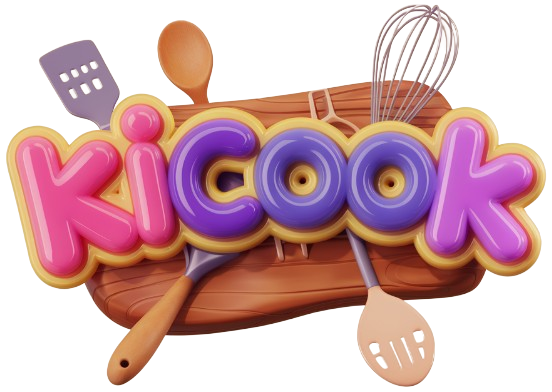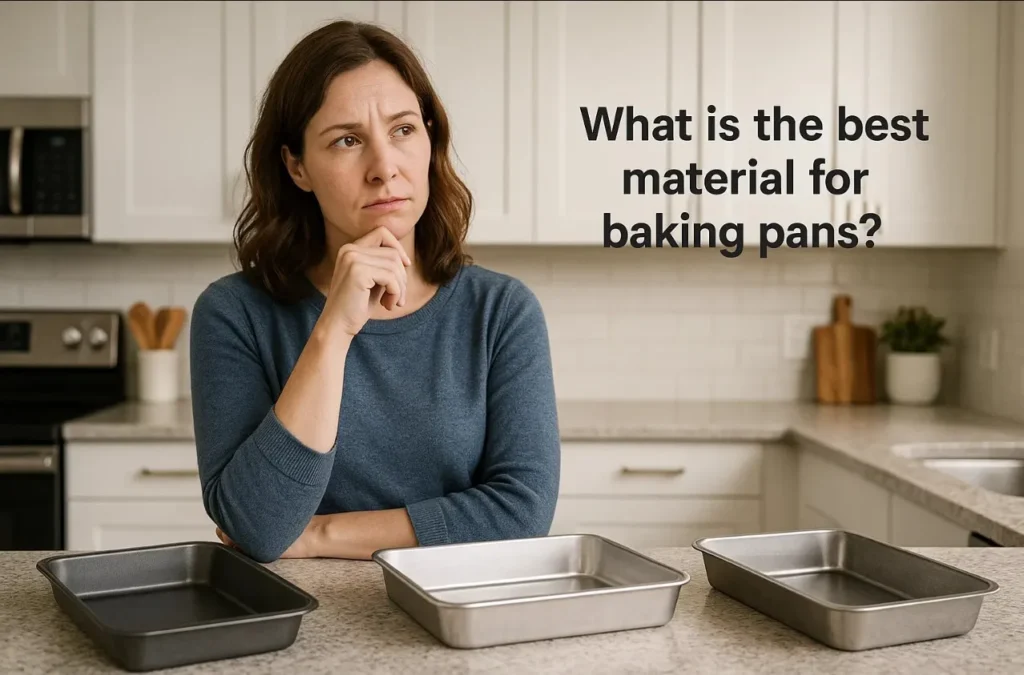I’ve always wondered what makes one baking pan better than another. Is it how evenly it bakes? Or maybe how easy it is to clean after? Choosing the best material for your baking pans isn’t just about looks. It’s about finding something that works well and lasts. Let’s dive into it together and explore “What Is The Best Material For Baking Pans?”
Main Points
- Aluminum pans are light, cheap, and heat evenly. They are great for baking cookies and cakes.
- Stainless steel pans last long and can go in the dishwasher. They work well for roasting and casseroles but might not heat evenly on all stoves.
- Cast iron pans keep heat well and are perfect for bread. However, they need extra care to keep their coating.
Aluminum: A Favorite for Baking Pans
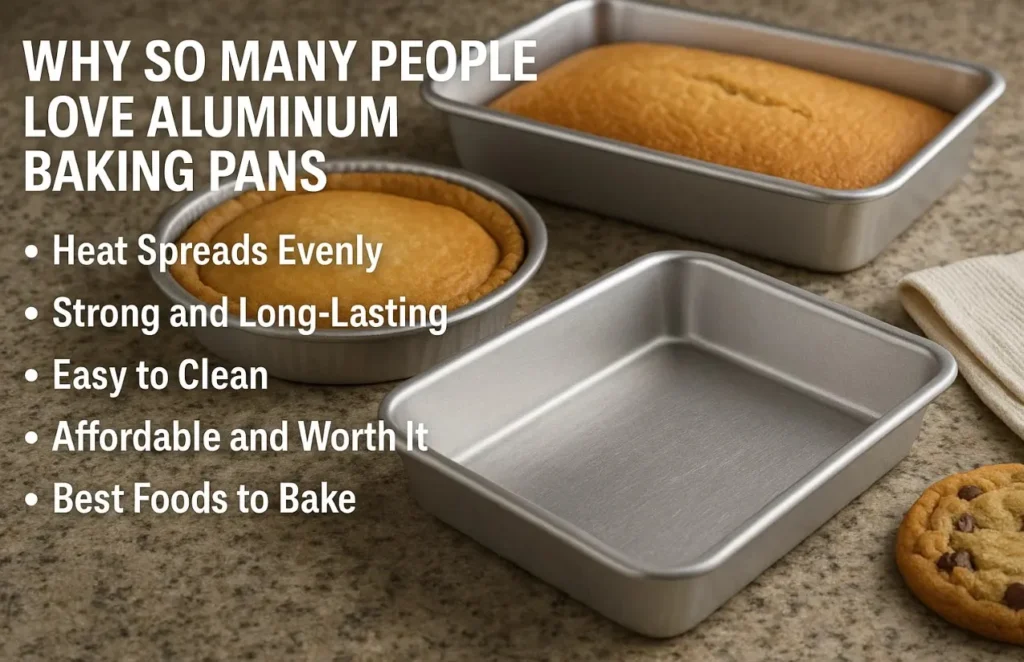
Aluminum pans are a top pick for baking. They’re light, cheap, and work great in the oven. Here’s why so many people love them.
Heat Spreads Evenly
Aluminum pans heat up fast and bake evenly. This means no more burnt edges or undercooked centers. Your cookies and cakes will turn out golden every time. But aluminum reacts with acidic foods like tomatoes. Coated or anodized aluminum pans fix this issue and still bake perfectly.
Strong and Long-Lasting
Aluminum pans last for years without breaking. They’re tough but not heavy, so they’re easy to use. Even at high heat, they don’t bend or warp. This makes them great for baking at any temperature.
Easy to Clean
Washing aluminum pans is simple. Warm water and soap clean them quickly. Non-stick or coated pans are even easier—no scrubbing needed! Just don’t use rough cleaners, as they can scratch the surface.
Affordable and Worth It
Aluminum pans don’t cost much, which is perfect for beginners. They’re a great deal because they last long and bake well. Even high-quality anodized pans are priced fairly.
Best Foods to Bake
I use aluminum pans for cookies, cakes, and roasted veggies. They’re dependable and work for almost anything. If you want a pan that’s affordable and reliable, aluminum is a great pick.
Stainless Steel: A Durable Baking Pan Material
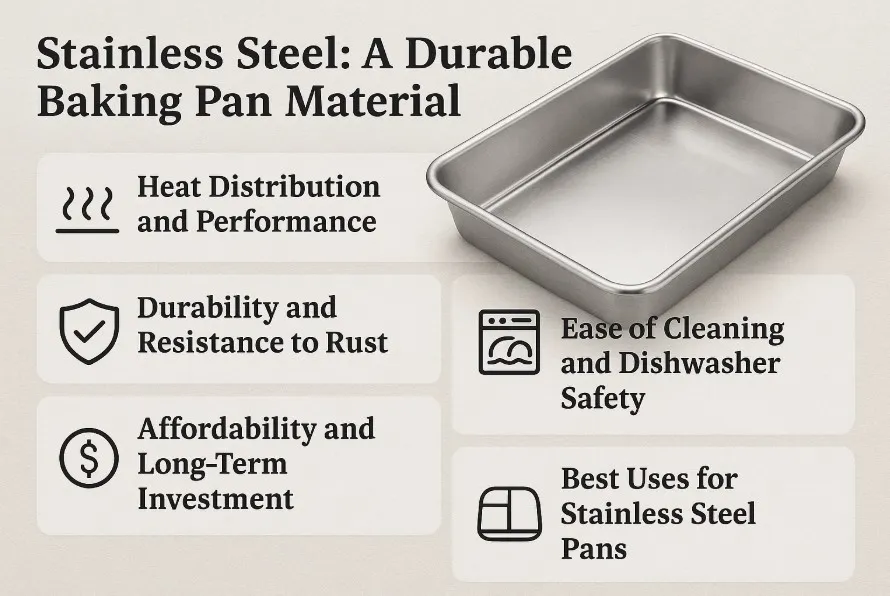
Stainless steel pans are my go-to when I need something tough and reliable. They’re built to last and can handle just about anything in the kitchen. Let me tell you why they’re worth considering.
Heat Distribution and Performance
Stainless steel pans heat up slower than aluminum, but they’re great at holding heat once they’re hot. I’ve found that they work best on gas stoves because the heat spreads more evenly. Consumer Reports even rated them “Excellent” for cooking evenness. If you’re using an electric or induction stove, though, you might notice some uneven heating.
Durability and Resistance to Rust
One thing I love about stainless steel is how durable it is. These pans don’t rust, even after years of use. I’ve dropped mine a few times, and they still look good as new. Unlike other materials, stainless steel doesn’t warp or crack, so it’s a solid long-term investment.
Ease of Cleaning and Dishwasher Safety
Cleaning stainless steel pans is pretty straightforward. They’re dishwasher-safe, which is a huge plus for me. But if you want to keep them shiny, handwashing is better. For stubborn stains or burnt spots, I use a little baking soda and vinegar—it works like magic!
Affordability and Long-Term Investment
Stainless steel pans are affordable, especially compared to premium materials. I’ve been using a Cuisinart Classic Stainless pan for years, and it’s still in great shape. It’s one of those purchases that pays off in the long run.
Best Uses for Stainless Steel Pans
I reach for my stainless steel pans when I’m roasting veggies or baking casseroles. They’re also perfect for recipes that need a quick sear before going into the oven. If you’re looking for the best material for durability and versatility, stainless steel is a fantastic choice.
Cast Iron: A Top Choice for Holding Heat
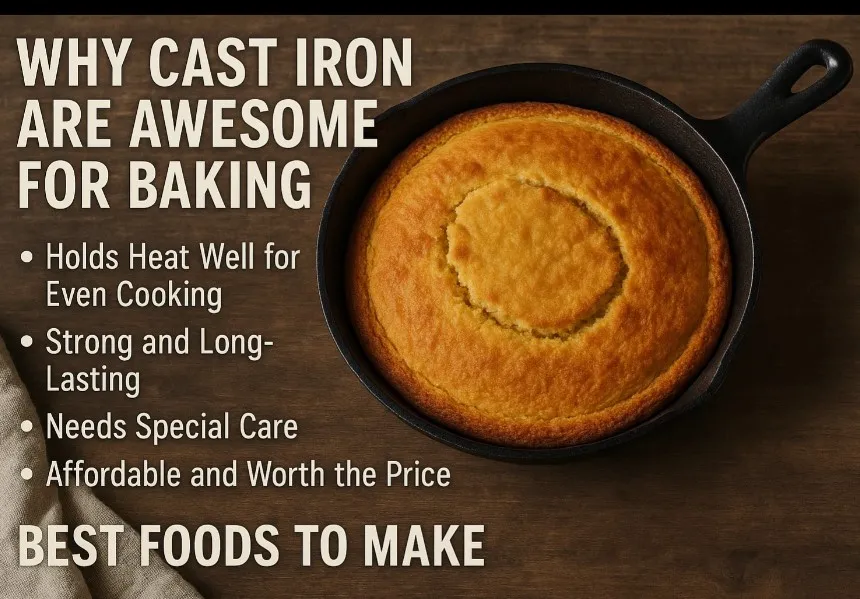
Cast iron pans are great for recipes needing steady heat. They’re tough, useful, and can last forever with care. Here’s why they’re awesome for baking.
Holds Heat Well for Even Cooking
Cast iron keeps heat longer than other pans. Once hot, it stays hot. This makes it ideal for baking cornbread or deep-dish pizza. Its thick walls help cook food evenly every time.
Strong and Long-Lasting
Cast iron pans are super durable. They don’t crack or bend easily. Many families pass them down for generations. With good care, they can last forever.
Needs Special Care
Taking care of cast iron pans takes work. You can’t use a dishwasher. They need seasoning, which means adding oil and baking it. Acidic foods like tomatoes can ruin the seasoning, so avoid them. Clean gently and dry quickly to stop rust.
Affordable and Worth the Price
Cast iron pans are not expensive for how strong they are. You can find good ones at fair prices. Since they last so long, they’re a smart buy.
Best Foods to Make
I use cast iron pans for bread, pies, and cookies. They’re also great for dishes that start on the stove and finish in the oven. Whether baking or frying, cast iron is a solid choice for cooking.
Glass: A Transparent Option for Baking Pans
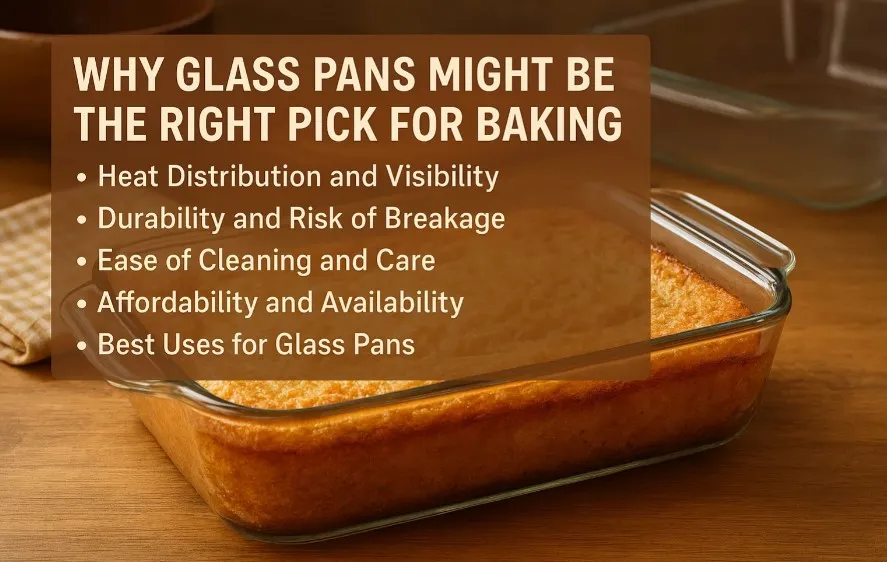
Glass pans are a unique choice for baking. I love how they let me see what’s happening inside while my food cooks. Let me share why glass pans might be the right pick for you.
Heat Distribution and Visibility
Glass pans heat up slower than metal ones, but they retain heat well. This makes them great for dishes that need steady, even cooking. I’ve noticed they’re perfect for casseroles and lasagnas. Plus, the transparency is a game-changer. You can peek at the bottom of your pie crust without opening the oven. How cool is that?
Durability and Risk of Breakage
Glass pans are sturdy, but they’re not unbreakable. I’ve had one crack when I accidentally placed it on a cold countertop right out of the oven. So, you’ll need to handle them with care. Avoid sudden temperature changes, and they’ll last a long time.
Ease of Cleaning and Care
Cleaning glass pans is a breeze. Most are dishwasher-safe, but I prefer handwashing mine to keep them looking clear and shiny. For baked-on food, a quick soak in warm soapy water does the trick. No special cleaners needed!
Affordability and Availability
Glass pans are affordable and easy to find. You can pick one up at almost any store. They’re a budget-friendly option for home bakers who want something reliable.
Best Uses for Glass Pans
I use glass pans for casseroles, pies, and baked pasta dishes. They’re also great for recipes where you want to monitor browning. If you’re looking for the best material for visibility and even cooking, glass is worth considering.
Silicone: A Great Choice for Non-Stick Baking
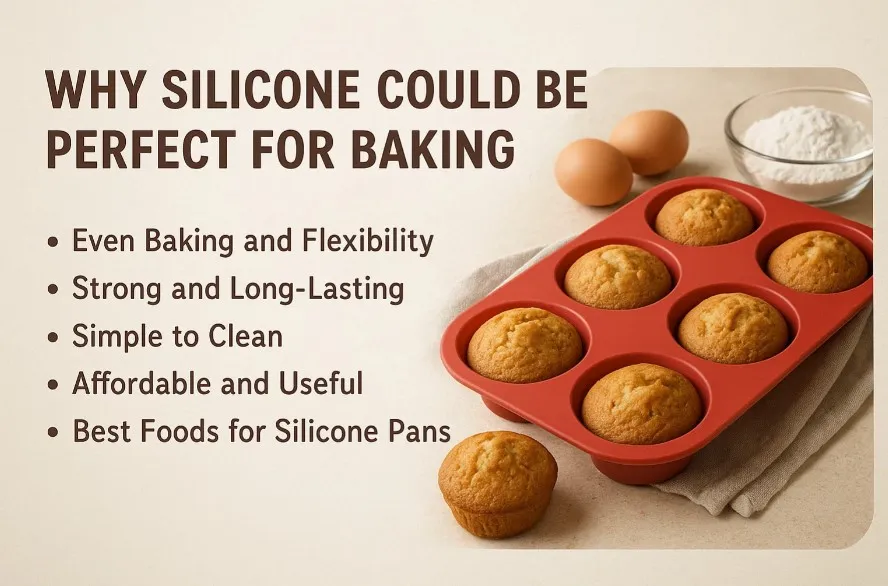
Silicone pans are super handy in the kitchen. They’re bendable, non-stick, and make baking easy. Here’s why they could be perfect for you.
Even Baking and Flexibility
Silicone pans heat slower than metal but bake evenly. They don’t brown food much, which is great for soft treats like muffins. Their bendy nature helps remove food easily. But they can feel floppy, so I always use a baking sheet underneath for support.
Strong and Long-Lasting
These pans are tough and made from safe silicone. They don’t wear out even after many uses. They can handle heat, cold, and even the microwave without damage.
Simple to Clean
Cleaning silicone pans is super easy. Food doesn’t stick, so most of the time, a quick wash with soapy water is enough. For stuck-on bits, soaking for a few minutes works well.
Affordable and Useful
Silicone pans are cheap and very useful. They’re light, easy to store, and work for many recipes. I recently made muffin tops in the air fryer, and they turned out great!
Best Foods for Silicone Pans
I use silicone pans for muffins, cupcakes, and soft desserts. They’re also awesome for no-bake treats like cheesecakes. If you want a non-stick, easy-to-clean pan, silicone is a great pick.
| Feature | Details |
|---|---|
| Safe Material | Made from food-safe silicone, no BPA included. |
| Non-Stick | Food comes out easily without sticking. |
| Durable | Handles heat and cold without damage. |
| Good Value | High quality at a low price. |
| Handling and Browning | Needs support; doesn’t brown food like metal pans. |
| Customer Review | I used these silicone pans for muffin tops in the air fryer. They worked great! Food came out easily, and they’re safe for ovens and microwaves. They need a pan underneath for stability, but cleaning is super simple!” |
Comparing the Best Materials for Different Baking Needs
Best Material for Cookies
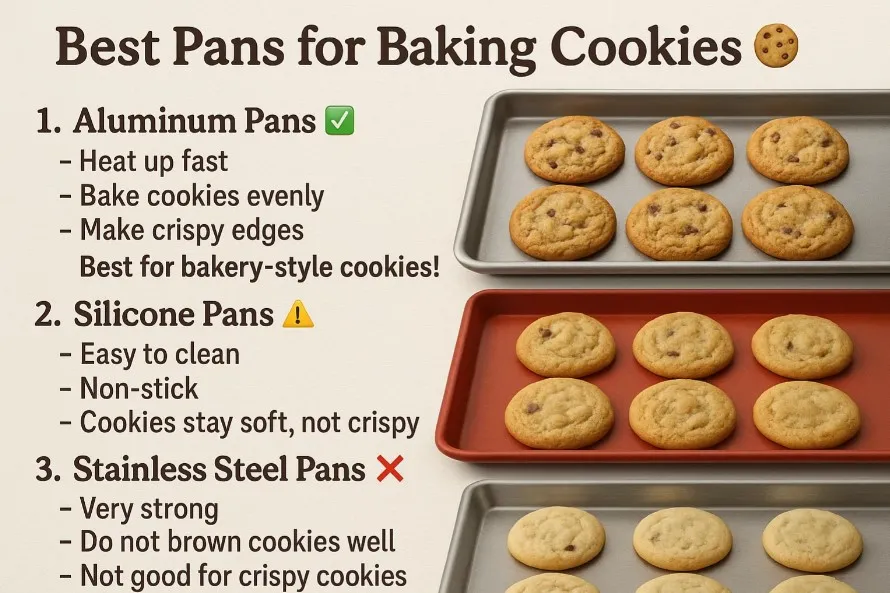
For cookies, aluminum pans are the best choice. They heat fast and bake evenly, giving cookies golden edges without burning. Stainless steel pans don’t brown cookies as well. Silicone pans are non-stick but don’t make cookies crispy.
Here’s a simple guide:
- Aluminum pans: Great for crispy edges and even browning.
- Silicone pans: Good for soft cookies but lack crispness.
- Stainless steel pans: Strong but not ideal for cookies.
If you want bakery-style cookies, go with aluminum pans.
Best Material for Cakes
Cakes need different pans. Anodized aluminum pans bake evenly and release cakes easily, especially with parchment paper. Glass pans let you see browning but heat slower, so baking takes longer. Silicone pans are non-stick but don’t brown cakes well.
Here’s what works:
- Anodized aluminum pans: Best for even baking and easy release.
- Glass pans: Good for visibility but need more baking time.
- Silicone pans: Non-stick but don’t brown cakes enough.
For cakes, I always use anodized aluminum pans. They’re reliable and easy to use.
Best Material for Bread
Bread needs pans that hold heat well. Cast iron pans are perfect for crusty bread. They keep heat steady, making a crispy crust and soft inside. For loaf bread, nonstick metal pans work great and are easy to clean. Silicone loaf pans are handy but don’t make a golden crust.
Here’s a quick comparison:
- Cast iron pans: Best for crusty artisan bread.
- Nonstick metal pans: Great for loaf bread and easy cleanup.
- Silicone loaf pans: Easy to use but lack browning.
For rustic bread, use cast iron pans. For loaf bread, choose nonstick metal pans.
Best All-Purpose Material for Home Bakers
If I had to pick one pan for everything, it’s aluminum. It’s cheap, light, and works well for all baking. Whether it’s cookies, cakes, or bread, aluminum pans always perform great. Tests show pans like the Nordic Ware Naturals are top-rated for their quality and price.
Why aluminum is the best:
- Performance: Bakes evenly every time.
- Ease of use: Light and simple to clean.
- Value: Affordable and lasts long.
For home bakers, aluminum pans are the best all-around choice.
Every pan material has its own benefits. Aluminum pans cook evenly and are simple to wash. Stainless steel is super durable. Cast iron keeps heat really well. Glass lets you watch your food bake. Silicone makes baking easy and mess-free. For most home bakers, aluminum is the top choice. It’s cheap, useful, and reliable for many baking needs.
FAQs For What Is The Best Material For Baking Pans?
What is the safest material for baking pans?
I recommend glass or silicone. Both are non-toxic and don’t react with food. Plus, they’re great for health-conscious bakers!
Can I use aluminum pans for acidic recipes?
Uncoated aluminum reacts with acidic foods like tomatoes. Use anodized or coated aluminum pans instead. They’re safe and won’t affect the flavor.
How do I prevent food from sticking to my pans?
Grease your pan with butter or oil. For extra protection, line it with parchment paper. Silicone pans are naturally non-stick, so no prep needed!
Conclusion
The best material for baking pans depends on what you’re making:
- Everyday baking? Try aluminum or nonstick.
- Even heat? Ceramic or anodized aluminum.
- Durability? Stainless steel or cast iron.
No single pan is perfect for everything, but knowing the pros and cons helps you choose wisely. Happy baking!
